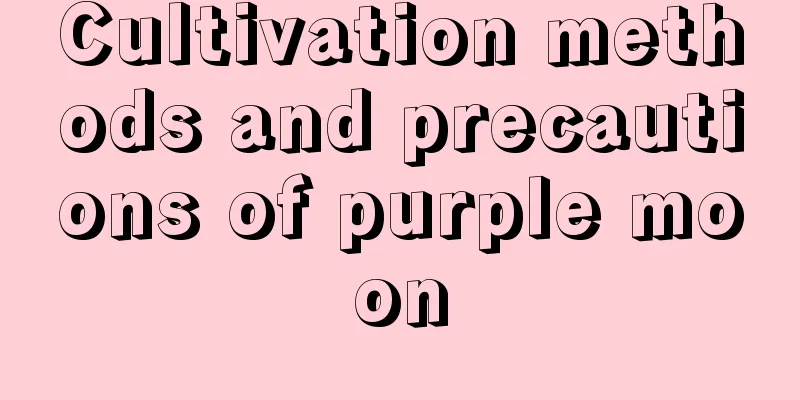Cultivation methods and precautions of purple moon

|
Purple Moon Plant, also known as Purple String Moon Plant, Purple Buddha Beads, etc., is a perennial succulent herb of the genus Asteraceae in the Asteraceae family. It is a very beautiful hanging succulent. So how do you grow this kind of succulent? What are the precautions? Let’s learn more about it below. Breeding methods and precautions - Image copyright belongs to All"> 1. Soil Purple Moon requires loose, permeable and fertile soil. It is recommended to use a mixture of peat, vermiculite, and perlite , and mix compound fertilizer into the soil before planting to ensure nutrition. 2. Lighting The growing environment of Purple Moon must have sufficient sunlight. When there is sufficient sunlight, the leaves will turn from green to purple. However, the hot summer is its dormant period, so it is still necessary to provide appropriate shade in the summer. 3. Temperature The suitable temperature for the growth of Purple Moon is 15℃-28℃. When the temperature in summer is higher than 30℃, Purple Moon will be in a semi-dormant state and should be avoided from exposure to the sun. The temperature should be kept above 5℃ in winter to avoid frost damage. 4. Watering Purple Moon Plant is not tolerant to waterlogging and needs sufficient water during the growing season. Just keep the soil slightly moist, and avoid water accumulation. When watering, do not water unless the soil is dry. Water thoroughly when the soil is dry. Do not water too frequently. Usually water once every 20 to 30 days. 5. Fertilization Purple Moonflower does not require much fertilizer . Generally, a thin layer of fertilizer is applied once a month during the plant's growth period, or a slow-release compound fertilizer is applied once in spring and autumn. 6. Notes (1) When the plant is growing vigorously, you can prune the dense or long branches appropriately to maintain the beautiful shape of the plant. (2) Check the plants regularly for diseases and insect pests, especially when there are signs of rot on branches and leaves, remove the rotten branches and leaves in time to avoid infection. (3) Repot the plant every 1-2 years to ensure the soil is loose and breathable. (4) The main method of propagation of Purple Moon is cuttings. After cuttings, be sure to place them in a bright and ventilated environment without direct sunlight, maintain a suitable temperature and wait for the cuttings to take root, then you can maintain them normally. In general, as a kind of succulent plant, Purple Moon Plant is relatively hardy and easy to grow. By following these basic breeding methods and precautions, even a novice can successfully raise the Purple Moon.
|
<<: Cultivation methods and precautions of island gardenia
>>: Cultivation methods and precautions of Sedum
Recommend
How to propagate stevia
Stevia cutting time There are spring and autumn c...
How to cut the roots of green radish
1. Root pruning method In fact, it is very simple...
Four Seasons Red Maple Seed Planting Method and Precautions
1. Planting method 1. Process the seeds: Wash the...
How to prune hawthorn
Hawthorn tree pruning When pruning hawthorn, you ...
What is the best month to plant small tomatoes?
When to plant small tomatoes Cherry tomatoes are ...
How to fertilize Platycodon grandiflorum
Spring fertilization In fact, this plant does not...
How to propagate large-leafed green radish and variegated green radish by cuttings
1. Cutting method of large-leafed green radish 1....
How to make the fairy finger bloom on New Year's Day
1. Flowering period of Immortal Finger The fairy ...
Does the five-leaf plum bloom all year round? (Methods and precautions for growing five-leaf plum at home)
How can the five-color plum blossom bloom in all ...
Can I grow a pear tree at home?
Can I grow a pear tree at home? You can plant pea...
What is the function of the fairy finger?
Radiation resistance The fairy finger can absorb ...
How to propagate yellow jasmine
1. Seed propagation If you want to use the sowing...
Cultivation methods and precautions of Pink Lady
1. Maintenance methods 1. Temperature: The temper...
How to grow lettuce
1. Prepare the soil Prepare a piece of open space...
Cultivation methods and precautions of Begonia truncatula
1. Maintenance methods 1. Soil: Begonia semperviv...









